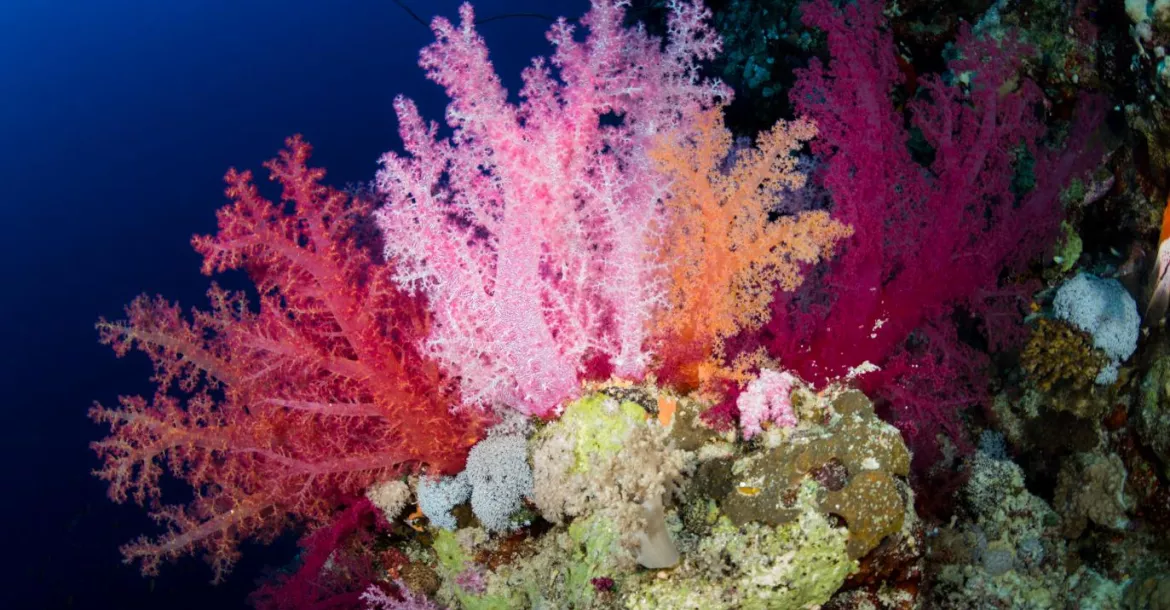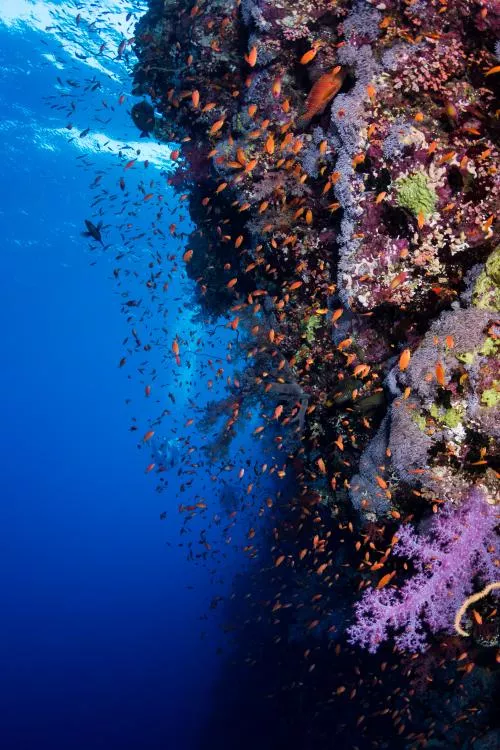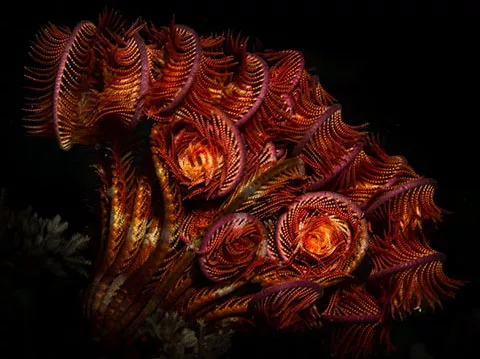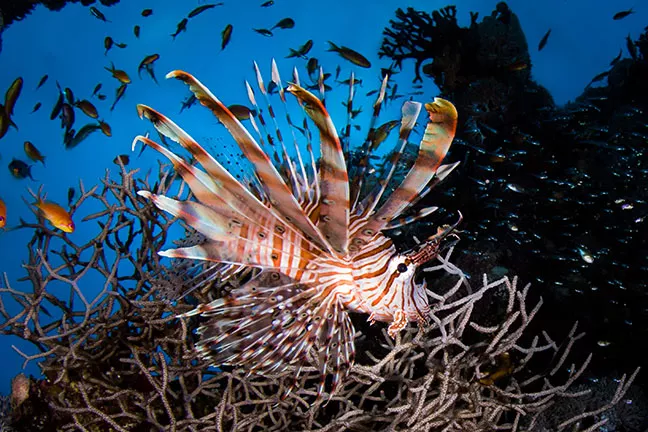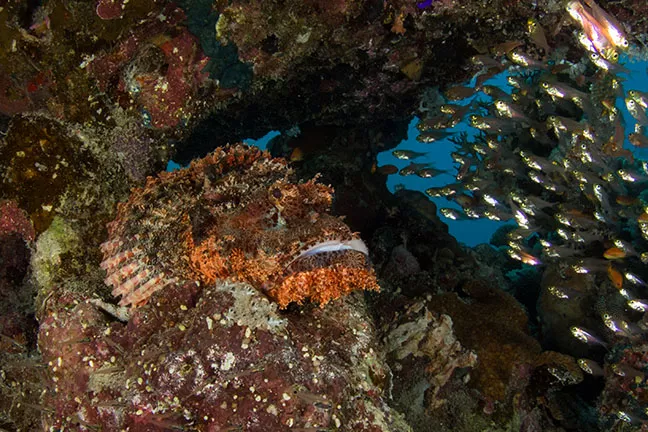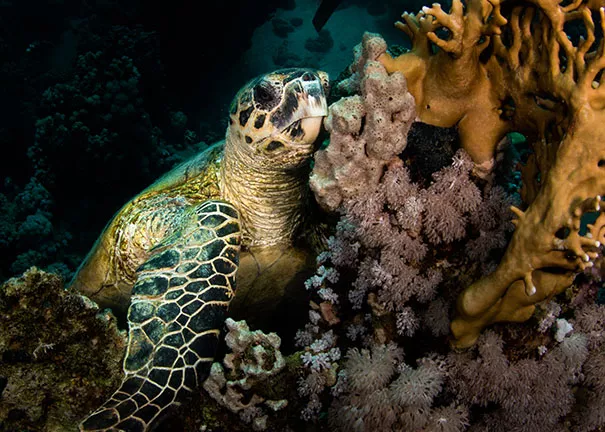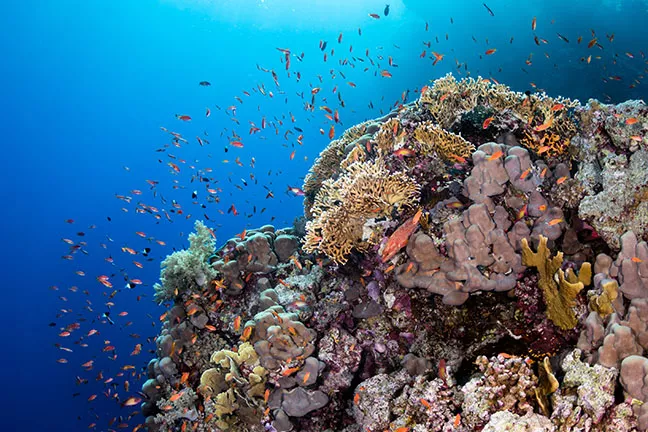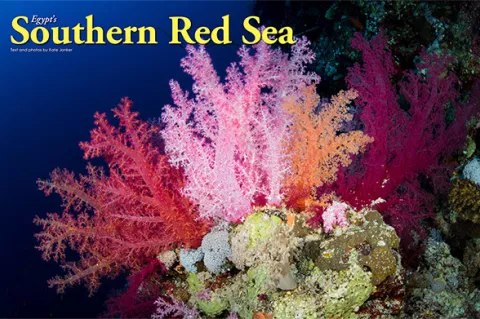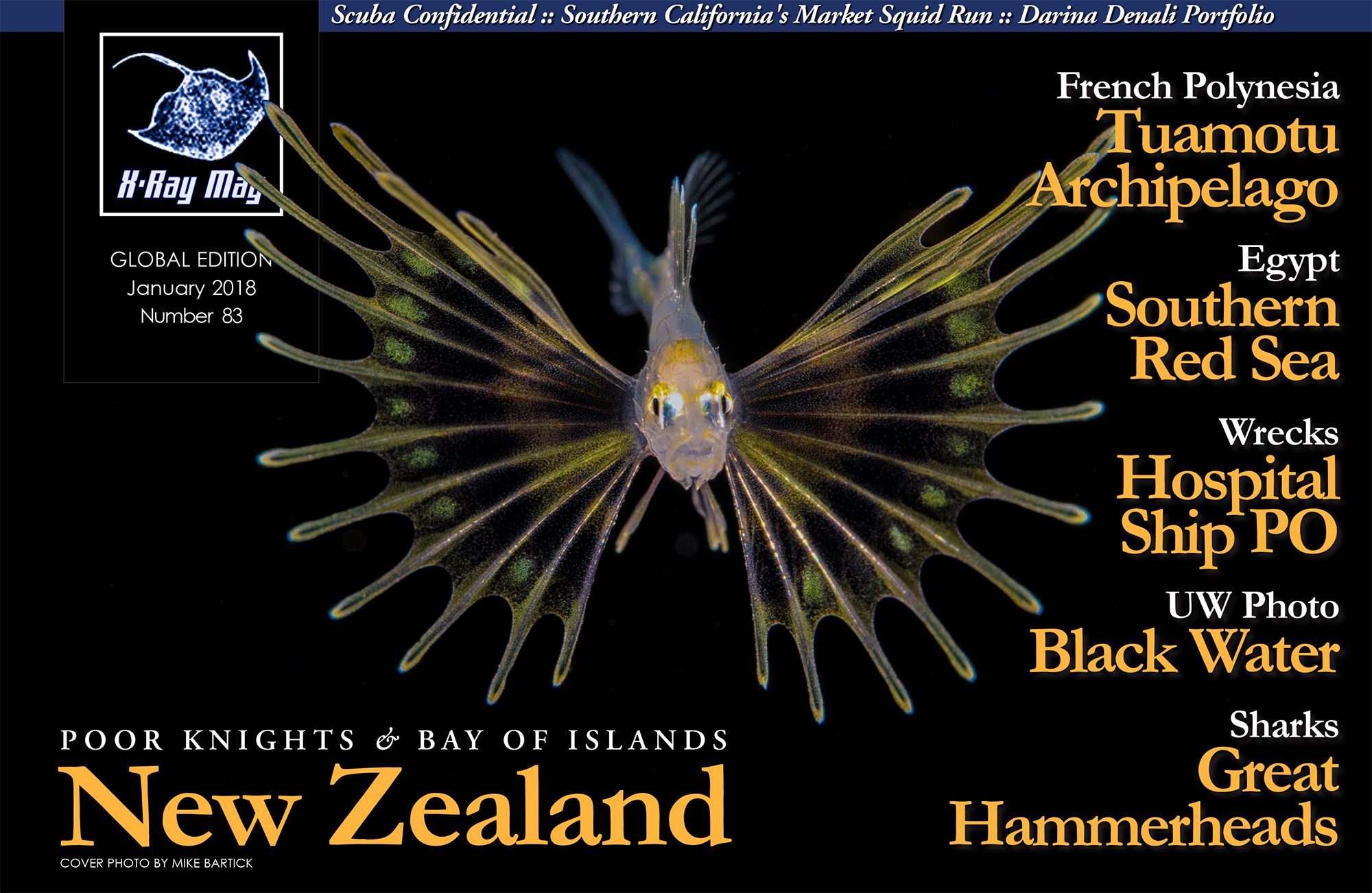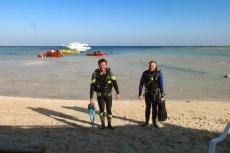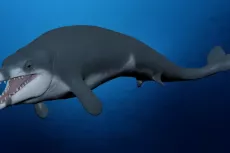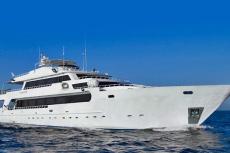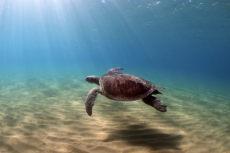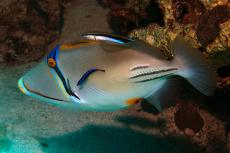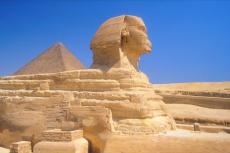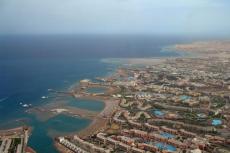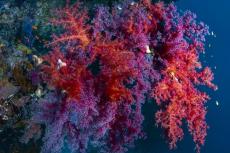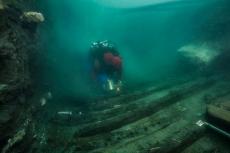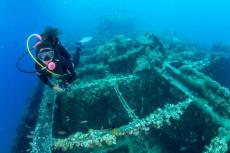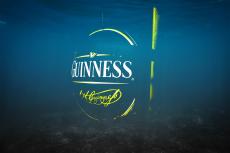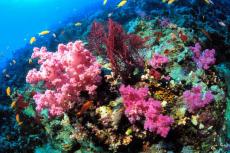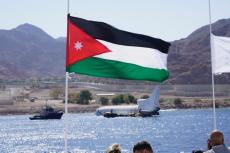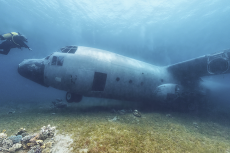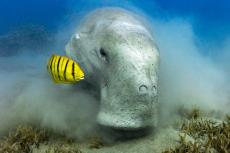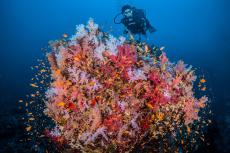Having dived in the northern Red Sea almost every year since 2005, I had come to Marsa Alam to join a liveaboard safari that would take me to the Deep South of the Egyptian Red Sea to explore St John’s reef and the Fury Shoal, just above the Sudanese border. I had heard rave reviews about the pristine coral reefs and the beautiful cave systems, of the dolphins and sharks and dugongs, and was here to find out for myself whether these claims were true.
Contributed by
Factfile
Kate Jonker is an underwater photographer and writer based in South Africa.
She teaches underwater photography, is an SSI Dive Control Specialist and dive boat skipper for Indigo Scuba in Gordon’s Bay and leads dive trips across the globe.
For more information, please visit: KateJonker.com.
The hot, dry desert air took my breath away and the merciless desert wind whipped my hair about my face as I stepped out onto the tarmac. After a one-hour flight from Cairo, I had arrived in Marsa Alam, and it felt good to be back in Egypt.
After being whisked through the airport, I loaded my luggage into the bus in true Egyptian style—through the back window. A short five-minute drive past hotels, apartment blocks and holiday resorts in various stages of development took passengers to the modern marina of Port Ghalib, where guests were to board the boat.
Port Ghalib
Port Ghalib is 65km north of Marsa Alam and, according to its official website, was the brainchild of Kuwaiti billionaire Nasser El Kharafi, who invested two billion dollars into turning this 18km stretch of uninhabited barren coastline into the region’s largest tourist area and marina complex. Today, it is home to many modern hotels and holiday resorts, and a palm-lined promenade that runs alongside the international marina hosts a wide selection of restaurants, bars and shops.
Once on board, guests were ushered into the cool, air-conditioned salon and offered a much-needed glass of ice cold juice. After a briefing and paperwork, I was allocated my room and went to unpack, choose my spot on the dive deck and kit up my gear. One of the guests had been on the Internet to check out the dive deck to see which spot was the best: “Not close to the wetsuits so that they flap in your face whilst kitting up and not too close to the main area so that you are swamped by fellow divers,” he advised me. He also said he looked at where the dive guides had their gear, as this was usually one of the best places to be.
We spent our first night in the marina waiting for those who were arriving on later flights from different parts of the globe. This is usually the norm, and most liveaboards only depart early the next morning.
Diving
We left Port Ghalib after an early breakfast and travelled south for two hours to our first destination, Abu Dabab Talata, where we would do our checkout dive to ensure our weighting was correct and our gear was working correctly.
Abu Dabab Talata. I did a giant stride off the back of the boat and was instantly enveloped by the soft, warm 28°C, clear blue water of the Red Sea. The reef was pristine, with huge porite and table corals, pinnacles towering up from a sandy floor dotted with coral bommies, each hosting its own community of banded dascyllus, half and half chromis and blue green chromis. Pairs of masked butterfly and Red Sea bannerfish wound their way slowly amongst the thriving communities. Blue-spotted stingrays rested on the ocean floor and a giant moray eel, accompanied by a bluefin trevally, patrolled the reef, looking for breakfast. Picasso triggerfish chased each other around the reef. It was June and mating season in the Red Sea, resulting in a lot of activity and rivalry amongst the fish.
Shaab Marsa Alam. The boat then made its way Shaab Marsa Alam for our last local dive before heading south. As there were 16 divers on the boat, we split ourselves into two groups, with each group having its own zodiac and dive guide.
Our zodiac took us to the far side of the reef. The skipper counted us down and after a backward roll, I descending onto the biggest, most prolific coral garden I have ever seen in my 17 years of diving. Coral-to-coral reef stretched as far as the eye could see, and above this reef hung schools of juvenile barracuda, yellowfin goatfish, blue striped and Ehrenberg’s snappers. Smaller reef fish went about their daily chores, flitting in between the branches of their coral homes.
The huge coral garden eventually gave way to sand, littered with coral bommies and large pinnacles, all hosting their own little fish cities. Orange anthias hung around the sunny sides of the pinnacles, and parrot fish and groupers swam amongst them, looking for a quick meal. I could have stayed there forever!
St John’s
We started the long trip south to St John’s at about 4:00 p.m. With huge swells relentlessly battering the port side of the boat, it was one of the roughest voyages I have ever experienced. At one stage, the sofas and chairs, with their seated occupants, slid from one side of the deck to the other. Fortunately, by about 6:00 p.m., the wind dropped, the sea flattened out and we had a comfortable journey south, finally reaching St John’s reef at 6:00 a.m. the following morning.
Paradise Reef. Our first dive at St John’s was on Paradise Reef, a beautiful, crescent-shaped reef with a gently sloping sandy bottom, dotted with large pinnacles that were home to many colourful reef fish, including yellowflank and sulphur damselfish, anthias, lionfish, Arabian and emperor angelfish and masked, striped and crown butterflyfish.
The reef wall was intersected by cracks, swim-throughs and gullies where sparkling light rays filtered through from the surface. A huge Napoleon wrasse with his entourage of a smaller Napoleon wrasse and bluefin trevally swaggered onto the reef like a gangster being followed by his minions. Shortly after that, a school of bumphead parrotfish swam lazily amongst the pinnacles in search of an early morning snack, their comical faces making them look like mischievous schoolboys. Sadly, by this stage, I was on my safety stop and had to watch from above—a photo opportunity missed. But such is diving!
Habili Gafar. After breakfast, a short ride took us to Habili Gafar, which simply has to be one of the most beautiful walls I have ever dived. We started our dive on this relatively small, pyramid- shaped reef at 26m and wound our way upwards.
The vibrant pink, orange, red and purple thistle soft corals were astounding, providing a beautiful contrast to the deep blue water, which plunged to depths of over 700m. Orange anthias hung along the entire side of the reef, adding to the riot of colour, and Red Sea bannerfish, broomtail wrasse, masked butterflyfish and rusty parrotfish swam alongside; whilst cornetfish hung silently, watching for a tasty snack. In stark contrast, silvery bluefin and yellowspotted trevallies and great barracudas patrolled the reef, looking for unsuspecting customers that would soon be lunch. We ended our dive at 5m on top of the reef, which was covered with pristine hard corals, before swimming back to the boat.
There’s a saying on Red Sea liveaboards—your hair is either wet, or it is dry. If it is wet, it is time to eat and if it is dry, it is time to dive.
To remind you of this, there is a large brass bell on every Red Sea liveaboard. “The Bell” is rung to call divers for a dive briefing or to a meal, and woe betide any diver who does not react promptly to the call of “The Bell.” Missing the bell results in a look of disapproval from the dive guide when you arrive late for a dive briefing, or a hurt look from the dining room steward if you are not first in the line for food.
Habili Ali. A very early first dive at Habili Ali the following morning saw us in the search of sharks. A bit ahead of the others, I spotted a grey reef shark, but by the time I had given everyone the point, “Look! Shark!” signal, it had swum out of sight. The other group was more fortunate than ours and sighted a scalloped hammerhead, a thresher shark and a whitetip reef shark.
Big St John’s Reef. Our next dive was on Big St John’s Reef where we were again on the lookout for sharks. We spotted two whitetip reef sharks in a cave as well as a number of medium-sized Napoleon wrasse. These two reefs reminded me very much of the Brothers Islands, with steep walls and lots of paler broccoli soft coral—not the pinks, red and purples of the previous day’s reefs.
St John’s Caves. Later in the day, we dived St John’s Caves. They were one of the reasons I had wanted to come to the southern Red Sea, and the dive exceeded all my expectations. I had seen many beautiful photos of the sun’s rays filtering down through cracks in the reef, but nothing prepared me for the breath-taking beauty of the light beams playing on the sandy floor.
This maze-like cave system is extensive, and although it is relatively shallow, giving nice long dives, one dive here is simply not enough. This incredible dive was made even more memorable by the inquisitive dolphins who joined us on our safety stop.
Many of our dives were taken from the back of the boat with an easy, giant stride off the dive platform. We had then either dived with the reef on our right-hand side or on our left-hand side and turned around to go back to the boat, or keep on diving and deploy our surface marker buoys for the zodiac to come and pick us up.
On other dives, the zodiacs took us to strategic spots on the reef. Once we had all put on our masks, the skipper would count us down and we would do a backward roll into the beautiful blue water. To ensure we started our dive at the right place on the reef, we often did negative entries, by taking all the air out of our BCDs before doing our backward rolls. We would then fin away from the boat and meet at 5m before heading to the reef.
Sataya Reef. The next morning, we made our way over to Sataya Reef and had one of the most memorable dives of my life (yes, another). A little way along the reef from the boat, we came across what can only be described as “Parrotfish Heaven.” There were parrotfish everywhere we looked—they were foraging for food, chasing each other, fighting for territory and generally, just being busy everywhere. I have never seen such a huge number and variety of parrotfish in one single place. There were Indian longnose parrotfish, ember, bullethead, redbreasted and steephead parrotfish to name just a few.
I was in awe. Even more so when my buddy started shouting at me and pointing at a magnificent oceanic whitetip shark that had emerged from the depths with its entourage of black and white striped pilot fish. The shark came to inspect us all and took a bit of a liking to my buddy Esther, circling her a number of times before lazily retreating back to the depths. It was a beautiful, aloof creature, and to have been in its presence was incredibly humbling. We continued with our dive back to the boat, hoping to catch another glimpse of him, but he did not reappear.
Night dives
Night dives were offered every evening and were fascinating. This is when the creatures that lurk in the dark come out into the open. We spotted Spanish dancers, huge stonefish, parrotfish sleeping in their protective mucous cocoons, massive basket stars that extended their arms to catch food in the water column, feather stars in a myriad of colours, strange sea cucumbers with their weird feeler-like mouth parts that crawled across the sand and masked puffer fish resting on the tops of rocks. Giant moray eels were seen foraging amongst the coral outcrops, and lionfish tried to hunt in our torch light. Night diving in the Red Sea is very special and on the southern reefs, it really was fantastic.
Diverse diving and marine life
The following days revolved around “The Bell.” We were either diving, eating, resting, sleeping, chatting to fellow divers or preparing our cameras for the next dive. The captain took us from one beautiful reef to another and our dive guides led us around pristine coral gardens teeming with life and beautiful reefs with steep, plunging walls adorned with hard and soft corals and huge gorgonian sea fans. We explored cracks and crevasses and even more cave systems and were on the constant look-out for sharks. Marine life continued to be colourful and plentiful and we saw more turtles, whitetip reef sharks and Napoleon wrasse. Conditions were perfect with flat sea, no wind and very little current at all.
Elphinstone. All too soon it was time to head north again to dive the infamous Elphinstone. Travelling overnight, we had a strong headwind and the sea became quite rough. Lying in my rocking bunk, my over-active mind played tricks on me. I started worrying about reefs hidden just below the surface, only to remind myself that the liveaboard captains came from generations of sea-farers, and that the ocean and its highways were in their blood.
The following morning, we awoke to a howling wind. We anchored up on the leeward side of Elphinstone, and the swells were huge. Massive waves were breaking over the top of the reef, and the boat was bucking against its anchor lines like a wild stallion.
Climbing onto the zodiac was challenging and required careful timing. A bumpy ride took us to the northern tip of the reef, where we did a negative entry and swam down along the plateau at 30m.
Suddenly, we came face to face with magnificent scalloped hammerhead shark, which turned with a flick of its tail and was gone. Sadly, this was the only shark we encountered on our dive.
When we surfaced, the swells had become even larger. Climbing back onto the liveaboard boat involved jumping off the zodiac, swimming to the ladder and clambering up it as quickly as possible. Not an easy task when wearing slippery fins. I had done this many times in the northern Red Sea, but those swells had been tiny in comparison. I was the second person to jump and was really scared—not for the climb up the ladder, which was totally submerged one minute and completely out of the water the next—but for the oceanic white tips that were swimming around the zodiac at the time! Fortunately, I made it back to the boat and up the ladder in one piece.
Due to the adverse conditions, it was agreed that we would skip the second dive at Elphinstone and search for dugongs instead. I was really excited as dugongs are at the top of my bucket list, and I had really hoped to see one on this trip.
Marsa Shouna. The captain took us to Marsa Shouna where many other liveaboards and day boats were seeking refuge from the strong wind and swells. Following our dive guide, we swam to the centre of the small bay, swivelling our heads from side to side in the search of dugongs.
The water was only 4m deep and the grassy sea bed was littered with bare patches of sand where, I imagined, dugongs had been grazing. As we swam, I was enthralled by the tiny juvenile fish hiding amongst the blades of grass and the shrimps with their goby partners in their tiny holes in the sand. Sadly, the dugongs did not make an appearance and we finished our final dive of the trip on a rather poignant note.
Afterthoughts
Heading back to Port Ghalib, I reflected on my trip. The Deep South was everything I had read about, and more. The coral gardens were pristine and teeming with reef fish, the walls were majestic with vibrant soft corals, hunting pelagic fish and colourful marine life. The cave systems were plentiful and awe-inspiring, with their dappled light and light beams streaming through cracks in the reef. It was the unexpected visitors—the dolphins, turtles and sharks—that added a sparkle of magic to the trip.
The deep south Red Sea liveaboard routes complement the northern routes by providing a varied and very different diving experience. Those wanting to see mainly sharks though, should consider doing the Brothers, Daedalus and Elphinstone route, and those with a lust for rust would be better off doing a wreck itinerary. Divers wanting a change from the northern region of the Red Sea will not be disappointed with a Deep South itinerary. I certainly look forward to returning again soon—and perhaps I will see the elusive dugong next time! ■

